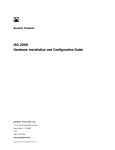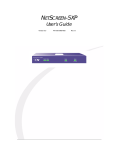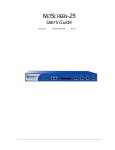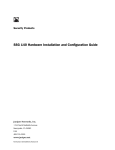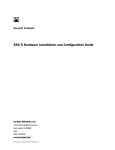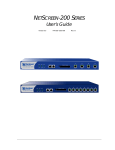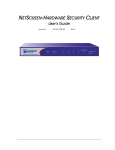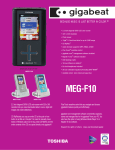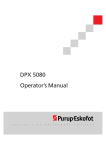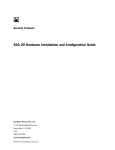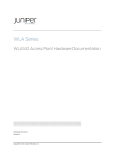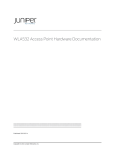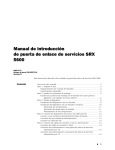Download ISG 1000 Hardware Installation and
Transcript
Security Products
ISG 1000
Hardware Installation and Configuration Guide
Juniper Networks, Inc.
1194 North Mathilda Avenue
Sunnyvale, CA 94089
USA
408-745-2000
www.juniper.net
Part Number: 093-1936-000, Revision B
Copyright Notice
Copyright © 2008 Juniper Networks, Inc. All rights reserved.
Juniper Networks, the Juniper Networks logo, NetScreen, and ScreenOS are registered trademarks of Juniper Networks, Inc. in the United States and
other countries. All other trademarks, service marks, registered trademarks, or registered service marks in this document are the property of Juniper
Networks or their respective owners. All specifications are subject to change without notice. Juniper Networks assumes no responsibility for any
inaccuracies in this document or for any obligation to update information in this document. Juniper Networks reserves the right to change, modify,
transfer, or otherwise revise this publication without notice.
FCC Statement
The following information is for FCC compliance of Class A devices: This equipment has been tested and found to comply with the limits for a Class A
digital device, pursuant to part 15 of the FCC rules. These limits are designed to provide reasonable protection against harmful interference when the
equipment is operated in a commercial environment. The equipment generates, uses, and can radiate radio-frequency energy and, if not installed and
used in accordance with the instruction manual, may cause harmful interference to radio communications. Operation of this equipment in a residential
area is likely to cause harmful interference, in which case users will be required to correct the interference at their own expense.
The following information is for FCC compliance of Class B devices: The equipment described in this manual generates and may radiate radio-frequency
energy. If it is not installed in accordance with Juniper Networks’ installation instructions, it may cause interference with radio and television reception.
This equipment has been tested and found to comply with the limits for a Class B digital device in accordance with the specifications in part 15 of the FCC
rules. These specifications are designed to provide reasonable protection against such interference in a residential installation. However, there is no
guarantee that interference will not occur in a particular installation.
If this equipment does cause harmful interference to radio or television reception, which can be determined by turning the equipment off and on, the user
is encouraged to try to correct the interference by one or more of the following measures:
Reorient or relocate the receiving antenna.
Increase the separation between the equipment and receiver.
Consult the dealer or an experienced radio/TV technician for help.
Connect the equipment to an outlet on a circuit different from that to which the receiver is connected.
Caution: Changes or modifications to this product could void the user's warranty and authority to operate this device.
Disclaimer
THE SOFTWARE LICENSE AND LIMITED WARRANTY FOR THE ACCOMPANYING PRODUCT ARE SET FORTH IN THE INFORMATION PACKET THAT SHIPPED
WITH THE PRODUCT AND ARE INCORPORATED HEREIN BY THIS REFERENCE. IF YOU ARE UNABLE TO LOCATE THE SOFTWARE LICENSE OR LIMITED
WARRANTY, CONTACT YOUR JUNIPER NETWORKS REPRESENTATIVE FOR A COPY.
2
Table of Contents
About This Guide
5
Organization .................................................................................................... 6
Conventions..................................................................................................... 6
Web User Interface Conventions .............................................................. 6
Command Line Interface Conventions ......................................................7
Requesting Technical Support .......................................................................... 7
Self-Help Online Tools and Resources........................................................ 7
Opening a Case with JTAC ......................................................................... 8
Feedback ......................................................................................................... 8
Chapter 1
Hardware Overview
9
Port and Interface Module Slots ..................................................................... 10
Front Panel .................................................................................................... 11
Device Status LEDs .................................................................................. 11
Port Descriptions ..................................................................................... 13
Ethernet Ports ................................................................................... 13
Compact Flash Slot ........................................................................... 13
Management Interfaces..................................................................... 14
Interface Modules .................................................................................... 14
10/100 Mbps Interface Module.......................................................... 14
10/100/1000 Mbps Interface Module................................................. 15
Mini-GBIC Interface Module............................................................... 15
Fan Tray .................................................................................................. 16
Back Panel ..................................................................................................... 16
Chapter 2
Installing and Connecting a Device
17
Before You Begin ........................................................................................... 18
Equipment Installation ................................................................................... 18
Connecting the Power.................................................................................... 20
AC Power Supply Unit ............................................................................. 20
DC Power Supply Unit ............................................................................. 20
Connecting Interface Cables to a Device ........................................................ 21
Connecting a Device to a Network .................................................................22
Connecting an ISG 1000 Device to an Untrusted Network .......................22
Connecting Ethernet Ports ................................................................ 23
Connecting a Modem Port.................................................................24
Connecting a Device to an Internal Network or a Workstation ................ 24
Chapter 3
Configuring a Device
25
Default Device Settings .................................................................................. 26
Accessing a Device......................................................................................... 27
Using a Console Connection .................................................................... 27
Table of Contents
3
ISG 1000 Hardware Installation and Configuration Guide
Using Telnet ............................................................................................ 28
Using Dialup ............................................................................................ 29
Using the WebUI ..................................................................................... 29
Basic Device Configuration ............................................................................ 29
Root Admin Name and Password ............................................................ 30
Date and Time......................................................................................... 31
Administrative Access ............................................................................. 31
Hostname and Domain Name .................................................................32
Default Route........................................................................................... 32
Management Interface IP Address ........................................................... 32
Management Services.............................................................................. 33
Trust Zone Interface IP Address............................................................... 33
Untrust Zone Interface IP Address ........................................................... 34
Policy Configuration ................................................................................ 34
Device Alarm........................................................................................... 35
File Transferring ...................................................................................... 35
High Availability Configuration....................................................................... 35
Restarting the Device ..................................................................................... 38
Restarting the Device with the CLI Reset Command................................ 38
Restarting the Device with the WebUI ..................................................... 38
Resetting a Device to Factory Defaults ........................................................... 40
Device Serial Number .............................................................................. 40
unset all................................................................................................... 41
Chapter 4
Servicing the Device
43
Required Tools and Parts ............................................................................... 44
Interface Modules .......................................................................................... 44
Remove Interface Module........................................................................ 44
Insert Interface Module............................................................................ 45
Power Supply Units........................................................................................ 46
DC Power Supply Replacement ............................................................... 46
AC Power Supply Replacement................................................................ 46
Fan Tray ........................................................................................................ 47
Fan-Tray Filter ............................................................................................... 48
Cables and Transceivers................................................................................. 49
Gigabit Ethernet Cables ........................................................................... 49
Mini-GBIC Transceiver ............................................................................. 50
Security Modules............................................................................................ 51
Appendix A
Specifications
53
Physical.......................................................................................................... 53
Electrical ........................................................................................................ 54
Environmental ............................................................................................... 54
Certifications.................................................................................................. 54
Connectors..................................................................................................... 56
Index.......................................................................................................................... 59
4
Table of Contents
About This Guide
The Juniper Networks Integrated Security Gateway (ISG) 1000 device integrates
firewall, deep inspection (DI), virtual private network (VPN), and traffic
management functionality in a low-profile, modular chassis. The ISG 1000 device is
ideal for medium-sized central enterprise sites, large regional sites, and security
data centers or server farms.
Built around a fourth-generation security ASIC, the GigaScreen3, the ISG 1000
device provides for flexible configuration with the following interface options for its
two open slots:
10/100 Mbps interface module, for 10/100Base-T connections (four and eight
ports)
10/100/1000 Mbps interface module, for 10/100/1000Base-T connections (two
ports)
Mini-GBIC interface module, for fiber-optic connections (two and four ports)
The chassis also has four built-in 10/100/1000 ports for a maximum of 20 ports that
can be configured per device.
NOTE:
The configuration instructions and examples in this document are based on the
functionality of a device running ScreenOS 6.1.0. Your device might function
differently depending on the ScreenOS version you are running. For the latest
device documentation, refer to the Juniper Networks Technical Publications
website at www.juniper.net/techpubs/hardware. To see which ScreenOS versions
are currently available for your device, refer to the Juniper Networks Support
website at http://www.juniper.net/customers/support/.
5
ISG 1000 Hardware Installation and Configuration Guide
Organization
This guide contains the following sections:
Chapter 1, “Hardware Overview,” describes the chassis and components of an
ISG 1000 device.
Chapter 2, “Installing and Connecting a Device,” describes how to mount and
connect cables and power to an ISG 1000 device.
Chapter 3, “Configuring a Device,” describes how to configure and manage an
ISG 1000 device and how to perform some basic configuration tasks.
Chapter 4, “Servicing the Device,” describes service and maintenance
procedures for an ISG 1000 device.
Appendix A, “Specifications,” provides general device specifications for an
SSG 1000 device.
Conventions
This guide uses the conventions described in the following sections:
“Web User Interface Conventions” on page 6
“Command Line Interface Conventions” on page 7
Web User Interface Conventions
The Web user interface (WebUI) contains a navigational path and configuration
settings. To enter configuration settings, begin by clicking a menu item in the
navigation tree on the left side of the screen. As you proceed, your navigation path
appears at the top of the screen, with each page separated by angle brackets.
The following example shows the WebUI path and parameters for defining an
address:
Policy > Policy Elements > Addresses > List > New: Enter the following, then
click OK:
Address Name: addr_1
IP Address/Domain Name:
IP/Netmask: (select), 10.2.2.5/32
Zone: Untrust
To open online Help for configuration settings, click the question mark (?) in the
upper left of the screen.
The navigation tree also provides a Help > Config Guide configuration page to help
you configure security policies and Internet Protocol Security (IPSec). Select an
option from the list and follow the instructions on the page. Click the ? character in
the upper left for Online Help on the Config Guide.
6
Organization
Command Line Interface Conventions
The following conventions are used to present the syntax of command line
interface (CLI) commands in text and examples.
In text, commands are in boldface type and variables are in italic type.
In examples:
Variables are in italic type.
Anything inside square brackets [ ] is optional.
Anything inside braces { } is required.
If there is more than one choice, each choice is separated by a pipe ( | ). For
example, the following command means “set the management options for the
ethernet1, the ethernet2, or the ethernet3 interface”:
set interface { ethernet1 | ethernet2 | ethernet3 } manage
NOTE:
When entering a keyword, you only have to type enough letters to identify the
word uniquely. For example, typing set adm u ang j12fmt54 is enough to enter
the command set admin user angel j12fmt54. Although you can use this shortcut
when entering commands, all the commands documented here are presented in
their entirety.
Requesting Technical Support
Technical product support is available through the Juniper Networks Technical
Assistance Center (JTAC). If you are a customer with an active J-Care or JNASC
support contract, or are covered under warranty, and need postsales technical
support, you can access our tools and resources online or open a case with JTAC.
JTAC policies—For a complete understanding of our JTAC procedures and
policies, review the JTAC User Guide located at
http://www.juniper.net/customers/support/downloads/710059.pdf.
Product warranties—For product warranty information, visit
http://www.juniper.net/support/warranty/.
JTAC hours of operation—The JTAC centers have resources available 24 hours a
day, 7 days a week, 365 days a year.
Self-Help Online Tools and Resources
For quick and easy problem resolution, Juniper Networks has designed an online
self-service portal called the Customer Support Center (CSC) that provides you with
the following features:
Find CSC offerings—http://www.juniper.net/customers/support/
Find product documentation—http://www.juniper.net/techpubs/
Requesting Technical Support
7
ISG 1000 Hardware Installation and Configuration Guide
Find solutions and answer questions using our Knowledge Base—
http://kb.juniper.net/
Download the latest versions of software and review your release notes—
http://www.juniper.net/customers/csc/software/
Search technical bulletins for relevant hardware and software notifications—
http://www.juniper.net/alerts/
Join and participate in the Juniper Networks Community Forum—
http://www.juniper.net/company/communities/
Open a case online in the CSC Case Manager—
http://www.juniper.net/customers/cm/
To verify service entitlement by product serial number, use our Serial Number
Entitlement (SNE) Tool—
https://tools.juniper.net/SerialNumberEntitlementSearch/
Opening a Case with JTAC
You can open a case with JTAC on the Web or by telephone.
Use the Case Manager tool in the CSC at http://www.juniper.net/customers/cm/.
Call 1-888-314-JTAC (1-888-314-5822—toll free in USA, Canada, and Mexico).
For international or direct-dial options in countries without toll-free numbers, visit
us at http://www.juniper.net/customers/support/requesting-support/.
Feedback
If you find any errors or omissions in this document, contact Juniper Networks at
[email protected].
8
Feedback
Chapter 1
Hardware Overview
This chapter provides detailed descriptions of the ISG 1000 chassis and modular
components. It includes the following sections:
“Port and Interface Module Slots” on page 10
“Front Panel” on page 11
“Back Panel” on page 16
9
ISG 1000 Hardware Installation and Configuration Guide
Port and Interface Module Slots
This section describes the location of the built-in ports and interface module slots.
Refer to Figure 1 for built-in port locations and Table 1 for the descriptions of the
ports, interface modules, and cable connectors.
Figure 1: Port and Interface Module Locations
Slot 1
Slot 2
Compact
Flash
Console
MGT Ethernet
Modem
Table 1: ISG 1000 Ports, Interface Modules, and Cable Connector Descriptions
Port
Description
Connector
1-4
Enables direct connections to workstations or a RJ-45
LAN connection through a switch or hub. This
connection also allows you to manage the device
through a Telnet session or the WebUI.
Speed/Protocol
10/100 Mbps Ethernet
Autosensing duplex and auto MDI/MDIX
Console
Enables a serial connection with the system.
Used for terminal-emulation connectivity to
launch CLI sessions.
RJ-45
9600 bps/RS-232C serial
Modem
Enables a backup RS-232 async serial Internet
connection through an external modem.
RJ-45
9600 bps — 115 Kbps/RS-232C serial
MGT
Provides a dedicated connection for
management traffic.
RJ-45
10/100Base-T
Compact
Flash
Allows you to download or upload device
software or configuration file, and to save log
files.
NA
NA
RJ-45
10/100Base-T
Interface Modules
10
FE4
4-port Fast Ethernet
FE8
8-port Fast Ethernet
RJ-45
10/100Base-T
GB2-TX
2-port Gigabit
RJ-45
10/100/1000Base-T
GB2-LX
2-port Mini GBIC with LX transceivers
LC
1000Base-LX
GB2-SX
2-port Mini GBIC with SX transceivers
LC
1000Base-SX
GB4-TX
4-port Mini GBIC with TX transceivers
RJ-45
10/100/1000Base-T
GB4-LX
4-port Mini GBIC with LX transceivers
LC
1000Base-LX
GB4-SX
4-port Mini GBIC with SX transceivers
LC
1000Base-SX
10GB1-SR/LR
1-port 10 Gigabit with XFP transceivers
LC
10Gbase-SR, 10Gbase-LR
Port and Interface Module Slots
Front Panel
This section describes the follow elements on the front panel of an ISG 1000 device:
Device Status LEDs
Port Descriptions
Interface Modules
Fan Tray
Device Status LEDs
The ISG 1000 device status LEDs display information about critical device functions.
When the system powers up, the POWER LED changes from off to blinking green,
and the STATUS LED changes in the following sequence: red, green, blinking green.
Startup takes approximately two minutes. If you want to turn the device off and on
again, we recommend you wait a few seconds between shutting it down and
powering it back up. Table 2 provides the name, color, status, and description of
each device status LED.
Table 2: Device LED Descriptions
Name
Color
Status
Description
POWER
Green
On steadily
Device is receiving power.
Off
Device is not receiving power.
Red
On steadily
Power supply is not functioning correctly.
Red
Blinking
Self-test failure occurred while ScreenOS was starting up.
Certain algorithm and ACL failures can cause this.
ALARM
Device alarm blinks once for each software attack.
Amber
On steadily
One of the following failures has occurred:
Power supply is off
Hardware failure
Error with software module
TEMP
STATUS
HA
Off
No alarm condition(s) present.
Green
On steadily
Temperature is within 32°F (0°C) to 131°F (55°C).
Orange
On steadily
Temperature is within 132°F (56°C) to 150°F (66°C).
Red
On steadily
Temperature exceeds 150°F (66°C).
Green
On steadily
Device is active.
Blinking
Device is starting.
Off
Device is off.
Green
On steadily
Device is the primary.
Amber
On steadily
Device is the backup.
Red
On steadily
HA is defined; device is not the backup.
Off
No HA activity is defined.
Front Panel
11
ISG 1000 Hardware Installation and Configuration Guide
Name
Color
Status
Description
FAN
Green
On steadily
All fans are functioning properly.
Red
On steadily
One or more fans failed or a fan subdevice is not
receiving power.
Green
On steadily
Security module is installed.
Off
No security module is installed.
On steadily
Security module is installed.
Off
No security module is installed.
On steadily
PC card is installed in the compact flash slot.
MOD1
MOD2
FLASH
12
Front Panel
Green
Green
Blinking
Read-write activity is detected.
Off
Compact flash slot is empty.
Port Descriptions
This section explains the purpose and function of the following components:
Ethernet Ports
Compact Flash Slot
Management Interfaces
Ethernet Ports
Four built-in 10/100 Ethernet ports provide LAN connections to hubs, switches, local
servers, and workstations. You can also designate an Ethernet port for management
traffic. The ports are labeled 1 through 4. For the default zone bindings for each
Ethernet port, see “Interface-to-Zone Binding” on page 26.
When configuring one of the ports, refer to the interface name that corresponds to
the location of the port. From left to right on the front panel, the interface names
for the ports are ethernet1/1 through ethernet1/4.
Figure 2 displays the location of the LEDs on each Ethernet port.
Figure 2: Activity Link LEDs Location
TX/RX
LINK
Table 3 describes the Ethernet port LEDs.
Table 3: Ethernet Port LEDs
Name
Color
LINK
Green
TX/RX
Green
Status
Description
On steadily
Port is online.
Off
Port is offline.
Blinking
Traffic is passing through. The baud rate is
proportional to the link activity.
Off
Port might be on but is not receiving data.
Compact Flash Slot
The compact flash slot enables you to download or upload device software or
configuration files and save log files to a compact flash card.
To save files to or from the device, use the following CLI command:
save { software | config } from { flash | slot1 filename } to { flash | slot1 filename }
where flash is the internal flash memory, slot1 is the compact flash slot, and
filename is the name of the software or configuration file on the compact flash card.
Front Panel
13
ISG 1000 Hardware Installation and Configuration Guide
Management Interfaces
The ISG 1000 offers three management interfaces:
Console Port — This RJ-45 serial port wired as data circuit-terminating
equipment (DCE) that can be used for local administration. Use a
straight-through cable when using a terminal connection and a crossover cable
when connecting to another DCE device. An RJ-45 to DB-9 adapter is supplied.
See “Connectors” on page 56 for the RJ-45 connector pinouts.
Modem Port — This RJ-45 serial port, wired as data terminal equipment (DTE)
that can be connected to a modem to allow remote administration. We do not
recommend using this port for regular remote administration. Use a
straight-through cable when connecting to a modem and a crossover cable
when connecting to another DTE device.
See “Connectors” on page 56 for the RJ-45 connector pinouts.
10/100 MGT Port — The management (MGT) port is a fixed 10/100Base-T
interface that provides a dedicated connection for management traffic. It has a
separate IP address and netmask (default is 192.168.1.1/24) and can be
configured with the Web User Interface (WebUI) and the command line
interface (CLI). The MGT port is only to be used for management purposes and
is not capable of routing traffic to other interfaces.
Interface Modules
The front panel of the ISG 1000 device has two interface module slots, which can
accommodate the following types of interface modules:
10/100 Mbps
10/100/1000 Mbps
Mini-GBIC
The modules are not hot-swappable. Your network administrator needs to
determine the kinds of interfaces needed to deploy an ISG 1000 device.
NOTE:
You can use one 10/100/1000 and one GBIC card in the same ISG 1000 device.
10/100 Mbps Interface Module
The four-port (FE4) or eight-port (FE8) 10/100 Mbps interface module is appropriate
for a 10/100Base-T LAN. Connect the ports using a crossover cable with RJ-45
connectors.
14
Front Panel
Figure 3: 10/100 Mbps Modules
10/100/1000 Mbps Interface Module
The two-port (GB2-TX) 10/100/1000 Mbps interface module is appropriate for a
10/100/1000 Base-T LAN. Connect the ports using a twisted pair cable with RJ-45
connectors.
Figure 4: Fixed 2-port 10/100/1000 Mbps Module
Mini-GBIC Interface Module
The two-port and four-port mini-GBIC interface modules provide connectivity to
fiber-based and copper-based gigabit Ethernet LANs. Connect the port using
appropriate cable type depending on the specific media used. Use single-mode or
multimode optical cable for SX and LX and CAT-5 cable for the 10/100/1000BaseT.
See “Interface Media Types for the Mini-Gigabit and 10Gigabit XFP Transceivers” on
page 57 for a list of each media type.
Figure 5: Two-Port and Four-Port Mini-GBIC Modules
Front Panel
15
ISG 1000 Hardware Installation and Configuration Guide
Fan Tray
The ISG 1000 device has a single hot-swappable three-fan tray, which you can
access on the left front side of the chassis.
WARNING: If a fan stops operating as a result of failure or removal, the device
continues to run. Do not leave the fan tray empty for more than two minutes;
otherwise, heat failure or permanent damage could occur.
Back Panel
The back panel of the ISG 1000 device contains a single factory-installed modular
power supply unit (PSU). The PSU is available for AC or DC use and weighs 1.5
pounds (.45 kilograms). The PSU attaches with thumbscrews to allow field
replacement. The POWER LED on the front panel of the ISG 1000 device glows
either green or red. Green indicates correct function, and red indicates PSU failure.
The AC PSU faceplate contains a power switch and a male power outlet.
The DC PSU faceplate contains a power switch, hex nut, and three DC power
terminal blocks that connect to power cables.
16
Back Panel
Chapter 2
Installing and Connecting a Device
This chapter describes how to install and connect an ISG 1000 device. It includes
the following sections:
NOTE:
“Before You Begin” on page 18
“Equipment Installation” on page 18
“Connecting Interface Cables to a Device” on page 21
“Connecting a Device to a Network” on page 22
For safety warnings and instructions, refer to the Juniper Networks Security
Products Safety Guide. The guide warns you about situations that could cause
bodily injury. When working on any equipment, be aware of the hazards involved
with electrical circuitry, and follow standard practices for preventing accidents.
17
ISG 1000 Hardware Installation and Configuration Guide
Before You Begin
The location of the device, the layout of the equipment rack, and the security of
your wiring room are crucial for proper device operation.
WARNING: To prevent abuse and intrusion by unauthorized personnel, install the
ISG 1000 device in a secure environment.
Observing the following precautions can prevent shutdowns, equipment failures,
and injuries:
Before installation, always check that the power supply unit (PSU) is
disconnected from any power source.
Ensure that the room in which you operate the device has adequate air
circulation and that the room temperature does not exceed 122° F (50° C).
Allow three feet (one meter) of clear space to the front and back of the device.
Do not place the device in an equipment rack frame that blocks an intake or
exhaust port. Ensure that enclosed racks have fans and louvered sides.
This device exceeds 36 pounds (16.3 kilograms). Take precautions when lifting
and stabilizing the device.
Correct these hazardous conditions before any installation: moist or wet floors,
leaks, ungrounded or frayed power cables, or missing safety grounds.
Equipment Installation
The ISG 1000 device fits into a standard 19-inch equipment rack and comes with
two mounting brackets and six screws for front-mount or center-mount installation.
To mount the ISG 1000 device, you need a number-2 phillips screwdriver (not
provided), the two mounting brackets, six screws (provided in the shipping box),
and four screws that are compatible with the equipment rack (not provided).
When correctly installed, the ISG 1000 device sits level in the equipment rack.
To front-mount an ISG 1000 device:
1. Using three screws, attach one mounting bracket to the front of one side of the
ISG 1000 device.
2. Using the remaining three screws, attach the other mounting bracket to the
front of the other side of the device.
3. Slide the device into the rack.
4. Support the device while you attach the left and right brackets to the rack frame
with the four screws (two on each side) that are compatible with the rack.
18
Before You Begin
Figure 6: Front-Mount ISG 1000
To center-mount as ISG 1000 device:
1. Using three screws, attach one mounting bracket to the middle of one side of
the ISG 1000 device.
2. Using the remaining three screws, attach the other mounting bracket to the
middle of the other side of the device.
3. Slide the device into the rack.
4. Support the device while you attach the left and right brackets to the rack frame
with the four screws (two on each side) that are compatible with the rack.
Figure 7: Center-Mount ISG 1000
Equipment Installation 19
ISG 1000 Hardware Installation and Configuration Guide
Connecting the Power
This section provides installation and connection procedures for the power supply
units (PSUs) available for the ISG 1000.
AC Power Supply Unit
To install and connect an AC PSU to the ISG 1000:
1. Slide the PSU into one of the power compartments in the back of the device.
2. Fasten the PSU to the device by tightening the corner screws into the eyelets on
the sides of the PSU.
3. Connect the female end of a standard power cord to the male connector on the
back of the PSU.
4. Connect the power cord to a standard 100-240-volt power outlet.
5. Press the power switch to the ON position.
DC Power Supply Unit
To install and connect a DC PSU to the ISG 1000:
WARNING: You must shut off current to the DC feed wires before connecting the
wires to the PSUs. Also, make sure that the ON/OFF switch is in the OFF position.
1. Slide the PSU into one of the power compartments in the back of the device.
2. Fasten the PSU to the device by tightening the corner screws into the eyelets on
the PSU sides.
3. Remove the hex nut on the grounding screw.
4. Place the ground lug on the screw, then tighten the hex nut securely.
5. Connect the other end of the grounding lug wire to a grounding point at your
site.
6. Loosen the retaining screws on each terminal block.
7. Insert the 0V DC (positive voltage) return wire into the center COM connector
and the -48V DC power-feed wire into either the left or right connector.
8. Fasten the screws over the connectors.
9. Press the power switch to the ON position.
20
Connecting the Power
Connecting Interface Cables to a Device
To connect the interface cable to a device:
1. Have ready a length of the type of cable used by the interface.
2. Insert the cable connector into the cable-connector port on the interface
faceplate.
3. Arrange the cable as follows to prevent it from dislodging or developing stress
points:
a.
Secure the cable so that it is not supporting its own weight as it hangs to
the floor.
b.
Place any excess cable out of the way in a neatly coiled loop.
c.
Use fasteners to maintain the shape of the cable loops.
WARNING: Certain ports on the device are designed for use as intrabuilding
(within-the-building) interfaces only (Type 2 or Type 4 ports as described in
GR-1089-CORE, Isssue 4) and require isolation from the exposed outside plant
(OSP) cabling. To comply with NEBS requirements and protect against lightning
surges and commercial power disturbances, the intrabuilding ports must not be
metallically connected to interfaces that connect to the OSP or its wiring. The
intrabuilding ports on the device are suitable for connection to intrabuilding or
unexposed wiring or cabling only. The addition of primary protectors is not
sufficient protection for connecting these interfaces metallically to OSP wiring.
CAUTION: To comply with intrabuilding lightning and surge requirements,
intrabuilding wiring must be shielded, and the shield for the wiring must be
grounded at both ends.
Connecting Interface Cables to a Device
21
ISG 1000 Hardware Installation and Configuration Guide
Connecting a Device to a Network
An ISG 1000 device provides firewall and general security for networks when it is
placed between internal networks and the untrusted network. This section
describes the following:
Connecting an ISG 1000 Device to an Untrusted Network
Connecting a Device to an Internal Network or a Workstation
Connecting an ISG 1000 Device to an Untrusted Network
You can connect your ISG 1000 device to an untrusted network in one of the
following ways:
Connecting Ethernet Ports
Connecting a Modem Port
The cabling instructions given below reproduce the configuration shown in Figure
8. However, this is not the only possible configuration. In addition, the instructions
assume that you have configured all physical ports and interfaces through the
Console port before cabling the device to a network.
The ports and interfaces are configured through the Console port as follows:
set interface ether1/1 zone dmz
set interface ethernet2/1 zone untrust
set interface ethernet3/8 zone trust
set interface mgt manage
save
22
Connecting a Device to a Network
To add an ISG 1000 device to your network:
1. Connect an RJ-45 straight-through cable from the MGT port (the default IP
address is 192.168.1.1/24) to your management workstation.
2. Connect an RJ-45 crossover cable from the first built-in 10/100/1000 interface
(ethernet1/1) to the DMZ switch, router, or hub.
3. Connect an optical cable from the far left interface of the GBIC module
(ethernet2/1) to the external router.
4. Connect an RJ-45 crossover cable from the last 10/100 Ethernet port in the FE8
interface module (ethernet3/8) to the internal switch, router, or hub.
5. Connect the power cable (included) to the ISG 1000 PSU and to a power source.
6. After the ISG 1000 starts up, the POWER, STATUS, and LINK LEDs should light
up as follows:
The POWER LED for each deployed power supply glows green.
The STATUS LED blinks green.
The top LINK LED for each interface blinks green. (For more details about
interpreting the Link Status LEDs, see “Interface Modules” on page 14.)
Figure 8: Basic Network Connection
External Router
Untrust
Trust
To power
MGT
DMZ
Connecting Ethernet Ports
To establish a high-speed connection, connect the provided Ethernet cable from the
Ethernet port marked 1on an ISG 1000 device to the external router. The device
autosenses the correct speed, duplex, and MDI/MDIX settings.
Connecting a Device to a Network
23
ISG 1000 Hardware Installation and Configuration Guide
Connecting a Modem Port
You can connect to the untrusted network with an RJ-45 straight-through serial
cable and an external modem.
Connecting a Device to an Internal Network or a Workstation
An ISG 1000 device contains four Ethernet ports. You can use one or more of these
ports to connect to LANs through switches or hubs. You can also connect one or all
of the ports directly to workstations, eliminating the need for a hub or switch. You
can use either crossover or straight-through cables to connect the Ethernet ports to
other devices. See “Default Device Settings” on page 26 for the default
zone-to-interface bindings.
24
Connecting a Device to a Network
Chapter 3
Configuring a Device
This chapter describes how to connect and configure an ISG 1000 device in your
network. It includes the following sections:
NOTE:
“Default Device Settings” on page 26
“Accessing a Device” on page 27
“Basic Device Configuration” on page 29
“High Availability Configuration” on page 35
“Restarting the Device” on page 38
“Resetting a Device to Factory Defaults” on page 40
After you configure a device and verify connectivity through the remote network,
you must register your product at http://www.juniper.net/customers/support/ so
certain ScreenOS services, such as Deep Inspection Signature Service and
Antivirus (purchased separately), can be activated on the device. After registering
your product, use the WebUI to obtain the subscription for the service. For more
information about registering your product and obtaining subscriptions for
specific services, refer to the Concepts & Examples ScreenOS Reference Guide for
the ScreenOS version running on the device.
25
ISG 1000 Installation and Configuration Guide
Default Device Settings
The ISG 1000 device supports a maximum of 20 ports, each of which can serve as a
physical interface. You can also configure Ethernet ports to serve as virtual (logical)
interfaces. The interfaces that can be configured on the ISG 1000 device are listed in
the following tables.
Table 4: Interface-to-Zone Binding
Port Label
Interface
Zone
Modem
serial
Untrust
MGT
mgt (default IP address is 192.168.1.1/24)
MGT
1
ethernet1/1
Null
2
ethernet1/2
Null
3
ethernet1/3
Null
4
ethernet1/4
Null
Interface Modules
starting at ethernet2/1 and 3/1 from left to right
Null
Table 5: Logical Interface Naming
Interface Type
Description
Ethernet interfaces
ethernetn1/n2 specifies a physical Ethernet interface. Ports are
numbered as follows: 1/1-n (four built-in 10/100/1000 Mbps ports),
2/1-n (top left module), and 3/1-n (top right module).
ethernetn1/n2.n3 specifies a sub-interface. Sub-interfaces are
numbered as follows: 1/1-n (four built-in 10/100/1000 Mbps ports),
2/1-n (top left module), and 3/1-n (top right module) and a logical
interface number ( .n3).
NOTE:
Layer-2 interfaces
vlan1 specifies the interface used for VPNs while the device is in
Transparent mode.
Tunnel interfaces
tunnel.n specifies a tunnel interface. Use this interface for VPN traffic.
Functional interface
mgt specifies an interface bound to the MGT zone. The default IP
address of this interface is 192.168.1.1/24.
For either operational mode, we strongly recommend that you change the default
IP address and subnet mask for the mgt interface.
In Transparent mode, only the mgt and vlan1 interfaces require a new IP address
and subnet mask. Other interfaces must keep the default IP address and subnet
mask settings (0.0.0.0 and 0.0.0.0, respectively). To access the vlan1 interface, you
must change the IP address and subnet mask of vlan1 to match the IP address of
your current network.
In Route mode (default), you must configure at least two Ethernet interfaces with
new IP addresses and subnet masks.
For information on configuring the operational modes, refer to the Concepts &
Examples ScreenOS Reference Guide.
26
Default Device Settings
Accessing a Device
You can configure and manage a device in several ways:
Console: The Console port on the device allows you to access the device
through a serial cable connected to your workstation or terminal. To configure
the device, you enter ScreenOS command line interface (CLI) commands on
your terminal or in a terminal-emulation program on your workstation.
WebUI: The ScreenOS Web user interface (WebUI) is a graphical interface
available through a browser. To initially use the WebUI, the workstation on
which you run the browser must be on the same subnetwork as the device. You
can also access the WebUI through a secure server using Secure Sockets Layer
(SSL) with secure HTTP (HTTPS).
Telnet/SSH: Telnet and SSH are applications that allow you to access devices
through an IP network. To configure the device, you enter ScreenOS CLI
commands in a Telnet session from your workstation. For more information,
refer to the Concepts & Examples ScreenOS Reference Guide.
Network and Security Manager (NSM): NSM is a Juniper Networks
enterprise-level management application that enables you to control and
manage Juniper Networks firewall/IPSec VPN devices. For instructions on how
to manage your device with NSM, refer to the Network and Security Manager
documentation at
http://www.juniper.net/techpubs/software/management/security-manager.
Using a Console Connection
NOTE:
Use a straight-through RJ-45 CAT5 serial cable with a male RJ-45 connector to plug
into the Console port on the device.
To establish a console connection:
1. Plug the female end of the supplied DB-9 adapter into the serial port of your
workstation. (Be sure that the DB-9 is inserted properly and secured.) Figure 9
shows the type of DB-9 connector that is required.
Figure 9: DB-9 Adapter
RJ-45 Jack
RJ-45 Cable
DB-9 Adapter
2. Plug the male end of the RJ-45 CAT5 serial cable into the Console port on the
ISG 1000. (Be sure that the other end of the CAT5 cable is inserted properly and
secured in the DB-9 adapter.)
Accessing a Device
27
ISG 1000 Installation and Configuration Guide
3. Launch a serial terminal-emulation program on your workstation. The required
settings to launch a console session are as follows:
Baud rate: 9600
Parity: None
Data bits: 8
Stop bit: 1
Flow Control: None
4. If you have not yet changed the default login for the login name and password,
enter netscreen at both the login and password prompts. (Use lowercase letters
only. The login and password fields are both case-sensitive)
For information on how to configure the device with the CLI commands, refer
to the Concepts & Examples ScreenOS Reference Guide.
5. (Optional) By default, the console times out and terminates automatically after
10 minutes of idle time. To remove the timeout, enter set console timeout 0.
6. Once the command prompt is displayed, the device is ready to be configured,
See “Basic Device Configuration” on page 29 to complete the initial device
configuration.
Using Telnet
To establish a Telnet connection:
1. Connect your workstation to the MGT port (mgt interface) on the device.
2. Ensure that your workstation is configured for DHCP or is statically configured
with an IP address in the 192.168.1.0/24 subnet.
3. Start a Telnet client application to the IP address for the mgt interface (the
default IP address is 192.168.1.1). For example, enter telnet 192.168.1.1.
The Telnet application displays the login prompt.
4. If you have not yet changed the default login for the login name and password,
enter netscreen at both the login and password prompts. (Use lowercase letters
only. The login and password fields are both case-sensitive)
5. (Optional) By default, the console times out and terminates automatically after
10 minutes of idle time. To remove the timeout, enter set console timeout 0.
6. Once the command prompt is displayed, the device is ready to be configured,
See “Basic Device Configuration” on page 29 to complete the initial device
configuration.
28
Accessing a Device
Using Dialup
Each ISG 1000 device provides a modem port that allows you to establish a remote
CLI session using a dialup connection through a 9600 bps modem. Dialing into the
modem establishes a dialup CLI connection. You must use an RJ-45-to-DB-9
(female-to-male) serial cable with a null modem adapter.
NOTE:
The terminal type for dialup sessions must be vt100. For example, in Hilgraeve
HyperTerminal, select Connect > Remote device > vt100 from the Term Type
menu.
Using the WebUI
To use the WebUI, the workstation from which you are managing the device must
initially be on the same subnetwork as the device. To access the device with the
WebUI:
1. Connect your workstation to the MGT port (mgt interface) on the device.
2. Ensure that your workstation is configured for Dynamic Host Configuration
Protocol (DHCP) or is statically configured with an IP address in the
192.168.1.0/24 subnet.
3. Launch your browser, enter the IP address for the mgt interface (the default IP
address is 192.168.1.1/24), then press Enter.
The WebUI application displays the login prompt.
4. If you have not yet changed the default login for the admin name and
password, enter netscreen at both the admin name and password prompts.
(Use lowercase letters only. The admin name and password fields are both
case-sensitive.)
Basic Device Configuration
This section describes the following basic configuration settings:
Root Admin Name and Password
Date and Time
Administrative Access
Hostname and Domain Name
Default Route
Management Interface IP Address
Management Services
Trust Zone Interface IP Address
Basic Device Configuration
29
ISG 1000 Installation and Configuration Guide
Untrust Zone Interface IP Address
Policy Configuration
Device Alarm
File Transferring
Root Admin Name and Password
The root admin user has complete privileges for configuring an ISG 1000 device. We
recommend that you change the default root admin name and password (both
netscreen) immediately.
To change the root admin name and password, use the WebUI or CLI as follows:
WebUI
Configuration > Admin > Administrators > Edit (for the Administrator Name
netscreen): Enter the following, then click OK:
Administrator Name:
Old Password: netscreen
New Password:
Confirm New Password:
NOTE:
Passwords are not displayed in the WebUI.
CLI
set admin name name
set admin password pswd_str
save
30
Basic Device Configuration
Date and Time
The time setting on an ISG 1000 device affect events such as the setup of VPN
tunnels. The easiest way to set the date and time on the device is to use the WebUI
to synchronize the device system clock with the workstation clock.
To configure the date and time on a device, use the WebUI or CLI as follows:
WebUI
1. Configuration > Date/Time: Click the Sync Clock with Client button.
A pop-up message prompts you to specify if you have enabled the daylight
saving time option on your workstation clock.
2. Click Yes to synchronize the system clock and adjust it according to
daylight saving time, or click No to synchronize the system clock without
adjusting for daylight saving time.
CLI
set clock
save
The set clock CLI command allows you to manually enter the date and time for the
device.
Administrative Access
By default, anyone in your network can manage a device if they know the admin
name and password.
To configure the device to be managed only from a specific host on your network,
use the WebUI or CLI as follows:
WebUI
Configuration > Admin > Permitted IPs: Enter the following, then click Add:
IP Address/Netmask: ip_addr/mask
CLI
set admin manager-ip ip_addr/mask
save
Basic Device Configuration
31
ISG 1000 Installation and Configuration Guide
Hostname and Domain Name
The domain name defines the network or subnetwork to which a device belongs,
while the hostname refers to a specific device. The hostname and domain name
together uniquely identify the device in the network.
To configure the hostname and domain name on a device, use the WebUI or CLI as
follows:
WebUI
Network > DNS > Host: Enter the following, then click Apply:
Host Name: hostname
Domain Name: domain_name
CLI
set hostname hostname
set domain domain_name
save
Default Route
The default route is a static route used to direct packets addressed to networks that
are not explicitly listed in the routing table. If a packet arrives at the device with an
address for which the device does not have routing information, the device sends
the packet to the destination specified by the default route.
To configure the default route on the device, use the WebUI or CLI as follows:
WebUI
Network > Routing > Destination > New (trust-vr): Enter the following, then
click OK:
IP Address/Netmask: 0.0.0.0/0.0.0.0
Next Hop
Gateway: (select)
Interface: ethernet1/1 (select)
Gateway IP Address: ip_addr
CLI
set route 0.0.0.0/0 interface ethernet1/1 gateway ip_addr
save
Management Interface IP Address
The default IP address and subnet mask settings for the mgt interface are
192.168.1.1 and 255.255.255.0, respectively. If you do not want to use this default
IP address, you need to assign a new interface address that matches your current
network. We recommend using the MGT interface exclusively for management.
To set the IP address of the MGT port to 10.100.2.183/16, use the WebUI or CLI as
follows:
32
Basic Device Configuration
WebUI
Network > Interfaces > Edit (for mgt): Enter 10.100.2.183/16 in the IP
address and netmask fields, then click Apply.
CLI
set interface mgt ip 10.100.2.183/16
save
Management Services
ScreenOS provides services for configuring and managing the device, such as
SNMP, SSL, and SSH, which you can enable for each interface.
To configure the management services on the device, use the WebUI or CLI as
follows:
WebUI
Network > Interfaces > Edit (for mgt): Under Management Services, select or
clear the management services you want to use on the interface, then click
Apply.
CLI
set interface mgt manage web
unset interface mgt manage snmp
save
Trust Zone Interface IP Address
The ISG 1000 device can communicate with your protected network through an
interface bound to the Trust zone. To allow an interface to communicate with
internal devices, you must assign it the IP address and subnet mask for your
protected network.
To set the ethernet3/1 interface to communicate with your trusted network, use the
WebUI or CLI as follows:
WebUI
Network > Interfaces > Edit (for ethernet3/1): Enter the following, then click
Apply:
Zone Name: Trust (select)
IP Address/Netmask: 10.250.2.1/16
CLI
set interface ethernet3/1 zone trust
set interface ethernet3/1 ip 10.250.2.1/16
save
Basic Device Configuration
33
ISG 1000 Installation and Configuration Guide
Untrust Zone Interface IP Address
The ISG 1000 device can communicate with external (untrusted) devices through an
interface usually bound to the Untrust zone. To allow an interface to communicate
with external devices, you must assign it a public IP address.
To set the ethernet1/1 interface to communicate with external devices, use the
WebUI or CLI as follows:
WebUI
Network > Interfaces > Edit (for ethernet1/1): Enter the following, then click
Apply:
Zone Name: Untrust (select)
IP Address/Netmask: 172.16.20.1/16
CLI
set interface ethernet1/1 zone untrust
set interface ethernet1/1 ip 172.16.20.1/16
get interface ethernet1/1
save
Policy Configuration
By default, the ISG 1000 device does not allow inbound or outbound traffic or traffic
to or from the DMZ. To permit (or deny) traffic, you must create access policies.
To create and save an access policy that permits all kinds of outbound traffic from
any host in your trusted LAN to any device on the untrusted network, use the
WebUI or CLI as follows:
WebUI
Policies > (From: Trust To: Untrust) > New: Enter the following, then click OK:
Name: Trust-Untrust
Source Address: Any (select)
Destination Address: Any (select)
Service: Any (select)
Action: Permit (select)
CLI
set policy from trust to untrust any any any permit
save
CAUTION: Your network might require a more restrictive policy than this sample
policy. This example is not a requirement for initial configuration. For detailed
information about access policies, refer to the Concepts & Examples ScreenOS
Reference Guide.
34
Basic Device Configuration
Device Alarm
The ISG 1000 device allows you to configure the chassis alarm, an audible warning
that sounds when a system fails or a hazardous event occurs.
To specify which failures and events trigger the chassis alarm, use the set chassis
audible-alarm string CLI command. Table 6 describes the keywords available for
the set chassis CLI command.
Table 6: Set Chassis Keywords
Keyword
Meaning
all
Enables all chassis alarms
battery
Sets the chassis alarm to sound when a battery fails
fan-failed
Sets the chassis alarm to sound when a fan fails
power-failed
Sets the chassis alarm to sound when a power supply fails
temperature
Sets the chassis alarm to sound when the temperature goes outside the
acceptable range
File Transferring
To download files from or upload files to the device, use the WebUI or CLI as
follows:
WebUI
Configure > Update > ScreenOS/Keys or Config File > Select the type of file
you wish to transfer, browse for the file that you wish to upload onto the device,
then click Apply.
Once you click Apply, the device restarts. This process could take up to several
minutes.
CLI
save { software | config } from { flash | slot1 filename } to { flash | slot1 filename }
where flash refers to internal flash memory, slot1 refers to the compact flash
slot, and filename is the name of the software or configuration file on the card.
High Availability Configuration
The ISG 1000 device does not have dedicated High Availability (HA) interfaces;
however, you can cable and configure two ports per device to behave as an HA
interface once the device is running. In an HA configuration, one device is
configured as the primary device and the other is configured as the backup. If the
primary device fails, the backup device takes over as the primary. Any number and
type of interface module port can be used as HA ports. The backup device must
have the same interface modules installed and ScreenOS configuration as the
primary device for HA to work correctly. Figure 10 illustrates an example of a basic
way to cable two ISG 1000 devices for HA.
High Availability Configuration 35
ISG 1000 Installation and Configuration Guide
NOTE:
We recommend 10/100/1000 Mbps interface or mini-GBIC interface modules for
HA ports. You cannot mix mini-GBIC and 10/100/1000 Mbps ports as HA ports.
For information on configuring HA, refer to the Concepts & Examples ScreenOS
Reference Guide.
Figure 10: HA Connection
Untrust Zone
R2
R1
Switch B
802.1Q Trunk
Switch D
HA2
HA1
4
PWR
ALARM
TEMP
FAN
MOD1
MOD2
STATUS
3
4
4
HA
PWR
ALARM
TEMP
FLASH
FAN
MOD1
MOD2
primary device
Switch A
STATUS
3
4
HA
FLASH
backup device
Switch C
Trust Zone
NOTE:
The provided cabling instructions reproduce the configuration shown in Figure 10;
however, this is not the only possible HA configuration. In addition, the
instructions assume that all physical ports and interfaces are still at their defaults.
If you have changed the port and interface configurations, the instructions might
not work properly.
To cable two ISG 1000 security devices together for HA and connect them to the
network:
1. Connect a 10/100Base-T crossover cable from the preferred HA1 port on the
primary device to the preferred HA1 on the backup device.
36
High Availability Configuration
2. Connect a 10/100Base-T crossover cable from the preferred HA2 port on the
primary device to the preferred HA2 on the backup device.
Configuring HA Ports
3. Set the HA interface by executing the following command on each device, for
example:
set interface ethernet2/1 zone ha
set interface ethernet2/2 zone ha
Master Unit
4. Connect a crossover cable from ethernet1/4 to the switch labeled Switch A.
5. Connect an optical cable from ethernet3/4 to the switch labeled Switch B.
Backup Unit
6. Connect a crossover cable from ethernet1/4 to the switch labeled Switch C.
7. Connect an optical cable from ethernet3/4 to the switch labeled Switch D.
Switches
8. Cable together switches A and C (which are connected to the ethernet1/4
ports).
9. Cable together switches B and D (which are connected to the ethernet3/4
ports).
10. Cable Switch B to the primary router (R1).
11. Cable Switch D to the secondary router (R2).
NOTE:
The switch ports must be defined as 802.1Q trunk ports, and the external routers
must be able to use either Hot Standby Router Protocol (HSRP) or Virtual Router
Redundancy Protocol (VRRP). For the best configuration method, refer to the
documentation for your switch or router.
12. Turn the power switch to the ON position for both ISG 1000 devices.
High Availability Configuration 37
ISG 1000 Installation and Configuration Guide
Restarting the Device
You may need to restart the device in order to implement new features, such as
when you change between route and transparent mode or when you add new
license keys.
The following sections describe two methods of restarting the device:
“Restarting the Device with the CLI Reset Command” on page 38
“Restarting the Device with the WebUI” on page 38
Restarting the Device with the CLI Reset Command
To restart the device with the CLI reset command:
1. Establish a console session with the device as described in “Using a Console
Connection” on page 28 or “Using Telnet” on page 30.
At a Windows workstation, the easiset way of opening a console connection is
to choose Start > Run and enter telnet ip_address.
The device prompts you for your login and password.
2. If you have not yet changed the default username and password, enter
netscreen at both the login and password prompts. (Use lowercase letters only.
The login and password fields are both case-sensitive.)
3. At the console prompt, enter:
reset
The device prompts you to confirm the reset:
System reset, are you sure? y/[n]
4. Enter Y.
The device restarts.
Restarting the Device with the WebUI
To restart the device with the WebUI:
1. Launch your browser and enter the IP address for the management interface
(the default IP address is 192.168.1.1), then press Enter.
The WebUI application displays the login prompt.
2. If you have not yet changed the default username and password, enter
netscreen at both the login and password prompts. (Use lowercase letters only.
The login and password fields are both case-sensitive.)
3. In the WebUI, choose:
Configuration > Update > ScreenOS/Keys
38
Restarting the Device
4. Click Reset.
An alert box prompts you to confirm that you want to reset the device.
5. Click OK.
The device resets. Also, an alert box prompts you to leave your browser open
for a few minutes and then log back into the device.
Restarting the Device 39
ISG 1000 Installation and Configuration Guide
Resetting a Device to Factory Defaults
If you lose the admin password, or you need to clear the configuration of your
device, you can reset the device to its factory default settings. Resetting the device
destroys any existing configurations and restores access to the device.
CAUTION: Resetting the device deletes all existing configuration settings and
disables all existing firewall and VPN services.
NOTE:
By default, the device recovery feature is enabled. You can disable it by entering
the CLI unset admin device-reset command. Also, if the security device is in FIPS
mode, the recovery feature is automatically disabled.
You can restore the device to its default settings using one of these methods:
Using the device serial number
Using the CLI unset all command
The following sections describe how to use these methods to reset the device to its
factory defaults.
Device Serial Number
To use the device serial number to reset the device to its factory defaults:
1. Start a Console session as described in “Using a Console Connection” on
page 27.
2. At the Login prompt, enter the device serial number.
3. At the Password prompt, enter the serial number again. The following message
appears:
!!! Lost Password Reset !!! You have initiated a command to reset the device to
factory defaults, clearing all current configuration and settings. Would you like to
continue? y/[n]
4. Press the y key. The following message appears:
!! Reconfirm Lost Password Reset !! If you continue, the entire configuration of the
device will be erased. In addition, a permanent counter will be incremented to
signify that this device has been reset. This is your last chance to cancel this
command. If you proceed, the device will return to factory default configuration,
which is: device IP: 192.168.1.1; username: netscreen, password: netscreen.
Would you like to continue? y/[n]
5. Press the y key to reset the device.
The system now resets and returns to the login prompt; the default login name and
password are both reset to netscreen.
40
Resetting a Device to Factory Defaults
unset all
To use the CLI unset all command, you will need to know the login name and
password. To reset the device to its factory defaults:
1. Start a Console session as described in “Using a Console Connection” on
page 27, then log in.
2. At the command prompt, enter unset all. The following message is displayed:
Erase all system config, are you sure y/[n] ?
3. Press y
4. Enter reset. Press n for the first question and y for the second question:
Configuration modified, save? [y]/n
System reset, are you sure? y/[n]
The system now resets and returns to the login prompt; the default login name and
password are both reset to netscreen.
Resetting a Device to Factory Defaults
41
ISG 1000 Installation and Configuration Guide
42
Resetting a Device to Factory Defaults
Chapter 4
Servicing the Device
This chapter describes service and maintenance procedures for an ISG 1000 device.
It includes the following sections:
NOTE:
“Required Tools and Parts” on page 44
“Interface Modules” on page 44
“Power Supply Units” on page 46
“Fan Tray” on page 47
“Fan-Tray Filter” on page 48
“Cables and Transceivers” on page 49
“Security Modules” on page 51
For safety warnings and instructions, refer to the Juniper Networks Security
Products Safety Guide. The guide warns you about situations that could cause
bodily injury. Before working on any equipment, you should be aware of the
hazards involved with electrical circuitry and familiar with standard practices for
preventing accidents.
43
ISG 1000 Installation and Configuration Guide
Required Tools and Parts
To replace some components on an ISG 1000 device, you need the following tools
and parts:
Electrostatic bag or antistatic mat
Electrostatic discharge (ESD) grounding wrist strap
Phillips screwdriver, 1/8-inch
Interface Modules
This section provides instructions on how to service the interface modules on an
ISG 1000 device.
Remove Interface Module
To remove an interface module from a slot:
WARNING: When removing interface modules, be sure that the power is in the
OFF position.
1. Unscrew the thumbscrews on each side of the interface module.
2. With your thumbs, pull the locking levers out.
3. Grip the levers, then gently slide the module straight out (Figure 11).
4. If you are not reinstalling an interface module into the empty slot, install a
blank faceplate over the slot to maintain proper airflow.
Figure 11: Remove Interface Module
44
Required Tools and Parts
Insert Interface Module
To insert an interface module into a module slot:
WARNING: When inserting interface modules, be sure that the power is in the OFF
position.
1. Align the side edges of the module with the grooves in the side walls of the slot
(Figure 12).
Figure 12: Insert Interface Module
2. Slide the module in until it is forced to stop.
3. With your thumbs, push in the locking levers to secure the module (Figure 13).
Figure 13: Lock Interface Module
WARNING: Pushing the latch before it contacts the ridge on the slot wall sets the
locking tab prematurely and seats the interface module improperly.
4. Secure the thumbscrews on each side of the interface module.
Interface Modules
45
ISG 1000 Installation and Configuration Guide
Power Supply Units
This section provides instructions on servicing the power supply units (PSUs)
available on an ISG 1000.
DC Power Supply Replacement
To replace the DC PSU:
WARNING: You must shut off current to the DC feed wires leading to the PSU. Also,
make sure that the ON/OFF switch on the PSU is in the OFF position.
1. Turn off the current and the PSU.
2. Loosen the three retaining screws on the terminal block.
3. Remove the feed wires.
4. Turn the thumbscrews counterclockwise to release the PSU.
5. Gripping the handle, gently pull out the PSU.
6. Insert the new PSU into the bay.
7. Secure the PSU by tightening the thumbscrews clockwise.
8. Insert the 0V DC (positive voltage) return wire into the COM connector and the
-48V DC power-feed wire into the -48V connector, then ground the wire into the
GND connector.
9. Fasten the screws over the connectors.
10. Press the power switch to the ON position.
AC Power Supply Replacement
To replace an AC PSU:
1. Press the power switch to the OFF position
2. Unplug the cord from the PSU.
3. Loosen the thumbscrews on the power supply by turning them
counterclockwise to release the PSU.
4. Lift the handle and pull straight out.
5. Insert the new PSU into the slot.
6. Fasten the PSU to the device by tightening the thumbscrews clockwise.
46
Power Supply Units
7. Connect the female end of a standard power cord to the male connector on the
back of the power supply.
8. Press the power switch to the ON position.
Fan Tray
NOTE:
During the one-year warranty period, you can obtain a replacement fan tray by
contacting the Juniper Customer Support. After the warranty period, contact the
Juniper Networks Sales department.
You need to replace the fan module when a failure occurs. When fan failure occurs,
the FAN LED glows red, and the device generates an event alarm and an SNMP trap.
WARNING: If a fan stops operating as a result of failure or removal, the device
continues to run. Do not leave the fan tray empty for more than two minutes;
otherwise, heat failure or permanent damage can occur.
To remove the fan module:
1. Pull the fan lever until it is fully extended.
2. Grip the sides, then gently slide the assembly straight out (Figure 14).
WARNING: Do not remove the fan module while the fans are still spinning.
Figure 14: Removing the Fan
3. Insert the new fan tray in the fan bay, then push it straight in.
4. Secure the fan tray in place by pushing the fan lever flat against the front panel.
Fan Tray
47
ISG 1000 Installation and Configuration Guide
Fan-Tray Filter
Before you replace the fan filter, make sure you have the following tools:
Flashlight or other light source
18-inch wooden ruler or at least a 45-centimeter length of wooden dowel
To replace the fan tray filter:
1. Remove the fan module (“Fan Tray” on page 47).
CAUTION: Use caution when removing the fan module and fan filter.
2. Pull the front edge of the filter from the Velcro backing, located on the device
wall.
3. Insert a wooden ruler between the filter and the device wall (Figure 15).
Figure 15: Loosening the Fan-Tray Filter
4. Push the wooden ruler toward the back of the device, gently lifting the filter as
you proceed.
5. Once the filter is separated from the Velcro backing, use your fingers to pull the
filter out of the fan-tray slot (Figure 16).
48
Fan-Tray Filter
Figure 16: Removing the Fan-Tray Filter
6. Carefully insert a new filter into the device. Use the wooden ruler as an aid to
guide the back edge of the filter to the end of the device wall.
7. Once the filter is fully inserted, push the wooden ruler against the surface of the
filter several times to ensure that the filter is secure against the Velcro backing
on the device wall.
CAUTION: Make sure that the filter is secure against the device wall; otherwise, the
filter will tear when you reinstall the fan tray.
8. Insert the fan tray into the chassis.
9. Secure the fan tray by pushing the fan lever flat against the front panel.
NOTE:
If the top cover of the device is accessible, you may find it easier to remove the
cover and access the filter from the top of the device.
NOTE:
An ISG 1000 or ISG 2000 device can operate without a fan-tray filter; however,
without the filter the device does not comply with NEBS standards.
Cables and Transceivers
This section provides information on how to connect the cables and transceivers to
some of the interface modules.
Gigabit Ethernet Cables
To connect a Gigabit Ethernet cable to a mini-GBIC transceiver port:
1. If you have not already done so, remove the two plastic fiber-protection caps
from the ends of the cable.
Cables and Transceivers
49
ISG 1000 Installation and Configuration Guide
2. Hold the cable connector between your thumb and forefinger, with your thumb
on top and your forefinger underneath. (Do not press the release on top of the
connector.)
3. Slide the connector into the transceiver port until it clicks into place. Because
the fit is close, you might have to apply some force to insert the connector. To
avoid damaging the connector, apply force evenly and gently.
To remove the cable from the transceiver port:
1. Make sure the transceiver latch is in a secured locked position (the latch is flat
against the front of the transceiver). Otherwise, when you attempt to remove
the cable, the transceiver might come out with the cable still attached.
Figure 17: Transceiver Latch
Front Edge
Latch
Latch
Transceiver
Locked Position
Latch is fully extended
Transceiver
Unlocked Position
Latch is pressed in
2. Hold the connector between your thumb and forefinger, with your thumb on
top and your forefinger underneath.
3. Using your thumb, press the connector release down, then forward. This action
loosens the connector from the transceiver port.
4. Gently but firmly pull the clip from the transceiver port.
Mini-GBIC Transceiver
To remove a mini-GBIC transceiver from an interface module:
1. Push in the transceiver release latch (located on the underside of the
transceiver) until it locks into place, disengaging the transceiver (Figure 18).
Figure 18: Releasing the Transceiver
Transceiver
Release Latch
2. Grasp the transceiver at both sides, and pull the transceiver toward you to
remove it from the interface module.
To install a mini-GBIC transceiver into an interface module, holding the transceiver
with the label face up, insert it into the transceiver slot.
50
Cables and Transceivers
Security Modules
Security modules are high-performance-processing subdevices that increase the
performance of the ISG 1000 for high CPU-usage services, such as Intrusion
Detection and Prevention (IDP).
CAUTION: Before you install or remove a security module, make sure the power is
OFF, the power cords are removed, and the device is placed on a stable table.
To install or remove a security module:
1. Remove the top cover from the device. (Remove the three screws located on the
sides and the back of the top cover.)
2. Insert the security module into an empty slot, starting with the slot closest to
the front.
3. After inserting the security module into the slot, use the insertion/extraction
handles to correctly install the module into the slot.
Once all of the security modules are installed, replace the cover, install the device in
the rack, connect the power cords, and then turn on the power.
Security Modules
51
ISG 1000 Installation and Configuration Guide
52
Security Modules
Appendix A
Specifications
This appendix provides general device specifications for the ISG 1000:
“Physical” on page 53
“Electrical” on page 54
“Environmental” on page 54
“Certifications” on page 54
“Connectors” on page 56
Physical
Table 7provides the physical specifications for the ISG 1000.
Table 7: ISG 1000 Physical Specifications
Description
Value
Chassis
dimensions
44.45 cm x 43.82 cm x 13.34 cm (17.5 inches x 17.25 inches x 5.25
inches)
Device weight
16.3 kilograms (36 lbs) with two modules and PSU
Physical
53
ISG 1000 Installation and Configuration Guide
Electrical
Table 8 provides the electrical specifications for the ISG 1000.
Table 8: ISG 1000 Electrical Specifications
Item
Specification
AC voltage
100 - 240 VAC +/- 10%
AC power
250 watts
AC input frequency 50-60 Hz
DC voltage
-48 VDC
DC power
250 watts
Fuse Rating
DC PS: 10 amps / 250 volts; AC PS: 56.3 amps / 250 volts
WARNING: Certain ports on the device are designed for use as intrabuilding
(within-the-building) interfaces only (Type 2 or Type 4 ports as described in
GR-1089-CORE, Isssue 4) and require isolation from the exposed outside plant
(OSP) cabling. To comply with NEBS requirements and protect against lightning
surges and commercial power disturbances, the intrabuilding ports must not be
metallically connected to interfaces that connect to the OSP or its wiring. The
intrabuilding ports on the device are suitable for connection to intrabuilding or
unexposed wiring or cabling only. The addition of primary protectors is not
sufficient protection for connecting these interfaces metallically to OSP wiring.
CAUTION: To comply with intrabuilding lightning and surge requirements,
intrabuilding wiring must be shielded, and the shield for the wiring must be
grounded at both ends.
Environmental
Table 9 shows the environmental specifications for the ISG 1000.
Table 9: ISG 1000 Environmental Tolerance
54
Electrical
Description
Value
Altitude
No performance degradation to 10,000 feet (3,048 meters)
Relative humidity
Normal operation ensured in relative humidity range of 10 to 90 percent,
noncondensing
Temperature
Normal operation ensured in temperature range of 32°F (0°C) to 122°F
(50°C)
Certifications
Table 10 provides the certifications available for the ISG 1000.
Table 10: ISG 1000 Certifications
Certification Type
Certification Name
NEBSa
NEBS Level 3
GR-63-Core: NEBS, Environmental Testing
GR-1089-Core: EMC and Electrical Safety for Network
Telecommunications Equipment
Safety
CAN/CSA-C22.2, No. 60950-1-03/UL 60950-1, EN 60950-1, IEC 60950-1
EMI
FCC class A, CE class A, C-Tick, VCCI Class A
a.An ISG 1000 or ISG 2000 device can operate without a fan-tray filter; however, without the filter
the device does not comply with NEBS standards.
Certifications
55
ISG 1000 Installation and Configuration Guide
Connectors
Figure 19 shows the location of the pins on the RJ-45 connector.
Figure 19: RJ-45 Pinouts
1 2 3 4 5 6 7 8
Table 11 lists the RJ-45 connector pinouts.
Table 11: RJ-45 Connector Pinouts
56
Connectors
Pin
Name
I/O
Description
1
RTS Out
O
Request To Send
2
DTR Out
O
Data Terminal Ready
3
TxD
O
Transmit Data
4
GND
NA
Chassis Ground
5
GND
NA
Chassis Ground
6
RxD
I
Receive Data
7
DSR
I
Data Set Ready
8
CTS
I
Clear To Send
Figure 20 shows the location of the pins on the DB-9 female connector.
Figure 20: DB-9 Female Connector
Table 12 provides the DB-9 connector pinouts.
Table 12: DB-9 Connector Pinouts
Pin
Name
I/O
Description
1
DCD
I
Carrier Detect
2
RxD
I
Receive Data
3
TxD
O
Transmit Data
4
DTR
O
Data Terminal Ready
5
GND
NA
Signal Ground
6
DSR
I
Data Set Ready
7
RTS
O
Request To Send
8
CTS
I
Clear To Send
9
RING
I
Ring Indicator
The Mini-Gigabit transceivers are compatible with the IEEE 802.3z Gigabit Ethernet
standard, and the 10Gbase-R transceivers are compatible with the IEEE 802.3ae
standard. Table 13 lists media types and distances for the different types of
interfaces used in the ISG 1000.
Table 13: Interface Media Types for the Mini-Gigabit and 10Gigabit XFP Transceivers
Standard
Media Type
Maximum Distance (in Meters)
1000Base-SX
50/125 μ m multimode fiber
500
50/125 μ m multimode fiber
550
62.5/125 μ m multimode fiber
220
62.5/125 μ m multimode fiber
275
50/125 μ m multimode fiber
550
62.5/125 μ m multimode fiber
550
9/125 μ single-mode fiber
10,000
100Base-TX
Category 5 and higher UTP cable
100
10Gbase-SR
850nm multimode fiber
26-300
10Gbase-LR
1310nm single-mode fiber
10,000
1000Base-LX
Connectors
57
ISG 1000 Installation and Configuration Guide
58
Connectors
Index
C
cabling
network interfaces.....................................................23
power supply.............................................................23
chassis alarm configuration ..............................................35
configuration
admin name and password .......................................30
administrative access ................................................31
date and time ............................................................31
default route ..............................................................32
host and domain name .............................................32
management services................................................33
through the WebUI ....................................................29
managing
through WebUI ..........................................................38
mini-GBIC transceiver, replacing .......................................50
modem .............................................................................29
modules
high availability .........................................................16
LEDs ..........................................................................12
removing ...................................................................44
N
NEBS certification .............................................................55
NEBS warning...................................................................21
D
DC power supply ..............................................................16
dialup connection .............................................................29
F
factory defaults, resetting to..............................................40
fan
LED ...........................................................................12
tray............................................................................16
fan filter replacement .......................................................48
P
power supply unit (PSU)
AC replacement .........................................................46
DC replacement.........................................................46
overview....................................................................16
R
resetting to factory defaults...............................................40
restarting the device .........................................................38
G
S
gigabit Ethernet cable
connecting.................................................................49
disconnecting ............................................................50
safety guidelines ...............................................................18
serial connection...............................................................29
setting
policies ......................................................................34
Trust IP address.........................................................33
Untrust IP address .....................................................34
H
high availability (HA)
cabling.................................................................35–40
LED ...........................................................................11
overview....................................................................35
W
WebUI, using ....................................................................38
I
installing modules.............................................................16
interface modules .............................................................14
L
LEDs .................................................................................11
logging on.........................................................................29
M
management
through a console ......................................................27
through a Telnet connection......................................28
Index
59
ISG 1000 Installation and Configuration Guide
60
Index




























































